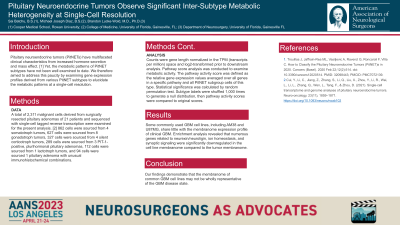Pituitary Neuroendocrine Tumors Observe Significant Inter-Subtype Metabolic Heterogeneity at Single-Cell Resolution
Pituitary Neuroendocrine Tumors Observe Significant Inter-subtype Metabolic Heterogeneity at Single-cell Resolution
Friday, April 21, 2023


Sai Batchu, BS (they/them/theirs)
Medical Student
Cooper Medical School
Montville, New Jersey, United States
ePoster Presenter(s)
Introduction: Pituitary neuroendocrine tumors (PitNETs) have multifaceted clinical characteristics from increased hormone secretion and mass effect. Yet, the metabolic patterns of PitNET subtypes have not been well examined to date. We therefore aimed to address this paucity by examining gene expression profiles derived from various PitNET subtypes to elucidate the metabolic patterns at a single-cell resolution.
Methods: A total of 2,311 malignant cells derived from surgically resected pituitary adenomas of 21 patients and sequenced with single-cell tagged reverse transcription were examined for the present analysis. 862 cells were sourced from 4 somatotroph tumors, 627 cells were sourced from 8 gonadotroph tumors, 327 cells were sourced from 4 silent corticotroph tumors, 289 cells were sourced from 3 PIT-1-positive, plurihormonal pituitary adenomas, 112 cells were sourced from 1 lactotroph tumors, and 94 cells were sourced 1 pituitary adenoma with unusual immunohistochemical combinations. Counts were gene length normalized in the TPM (transcripts per million) space and log2-transformed prior to downstream analysis. Pathway score analysis was conducted to examine metabolic activity. The pathway activity score was defined as the relative gene expression values averaged over all genes in a specific pathway and all PitNET subgroup cells of this type. Statistical significance was calculated by random permutation test. Subtype labels were shuffled 1,000 times to generate a null distribution, then pathway activity scores were compared to original scores.
Results: Gonadotroph tumors demonstrated enrichment for histidine metabolism. Conversely, histidine metabolism was depleted in lactotroph tumors. Somatotroph tumors comparatively upregulated genes involved in sulfur and tyrosine metabolism, while lactotroph tumors upregulated genes involved in the metabolism of nitrogen, ascorbate, and aldarate. PIT-1 lineage tumors were enriched for sulfur and thiamine metabolism.
Conclusion : These results highlight the profound metabolic diversity amongst PitNET subgroups and sets precedence for further studies to examine cellular metabolism of PitNETs to investigate novel avenues for targeted therapies.
Methods: A total of 2,311 malignant cells derived from surgically resected pituitary adenomas of 21 patients and sequenced with single-cell tagged reverse transcription were examined for the present analysis. 862 cells were sourced from 4 somatotroph tumors, 627 cells were sourced from 8 gonadotroph tumors, 327 cells were sourced from 4 silent corticotroph tumors, 289 cells were sourced from 3 PIT-1-positive, plurihormonal pituitary adenomas, 112 cells were sourced from 1 lactotroph tumors, and 94 cells were sourced 1 pituitary adenoma with unusual immunohistochemical combinations. Counts were gene length normalized in the TPM (transcripts per million) space and log2-transformed prior to downstream analysis. Pathway score analysis was conducted to examine metabolic activity. The pathway activity score was defined as the relative gene expression values averaged over all genes in a specific pathway and all PitNET subgroup cells of this type. Statistical significance was calculated by random permutation test. Subtype labels were shuffled 1,000 times to generate a null distribution, then pathway activity scores were compared to original scores.
Results: Gonadotroph tumors demonstrated enrichment for histidine metabolism. Conversely, histidine metabolism was depleted in lactotroph tumors. Somatotroph tumors comparatively upregulated genes involved in sulfur and tyrosine metabolism, while lactotroph tumors upregulated genes involved in the metabolism of nitrogen, ascorbate, and aldarate. PIT-1 lineage tumors were enriched for sulfur and thiamine metabolism.
Conclusion : These results highlight the profound metabolic diversity amongst PitNET subgroups and sets precedence for further studies to examine cellular metabolism of PitNETs to investigate novel avenues for targeted therapies.
